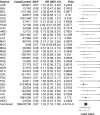Variants in genes encoding small GTPases and association with epithelial ovarian cancer susceptibility
- PMID: 29979793
- PMCID: PMC6034790
- DOI: 10.1371/journal.pone.0197561
Variants in genes encoding small GTPases and association with epithelial ovarian cancer susceptibility
Abstract
Epithelial ovarian cancer (EOC) is the fifth leading cause of cancer mortality in American women. Normal ovarian physiology is intricately connected to small GTP binding proteins of the Ras superfamily (Ras, Rho, Rab, Arf, and Ran) which govern processes such as signal transduction, cell proliferation, cell motility, and vesicle transport. We hypothesized that common germline variation in genes encoding small GTPases is associated with EOC risk. We investigated 322 variants in 88 small GTPase genes in germline DNA of 18,736 EOC patients and 26,138 controls of European ancestry using a custom genotype array and logistic regression fitting log-additive models. Functional annotation was used to identify biofeatures and expression quantitative trait loci that intersect with risk variants. One variant, ARHGEF10L (Rho guanine nucleotide exchange factor 10 like) rs2256787, was associated with increased endometrioid EOC risk (OR = 1.33, p = 4.46 x 10-6). Other variants of interest included another in ARHGEF10L, rs10788679, which was associated with invasive serous EOC risk (OR = 1.07, p = 0.00026) and two variants in AKAP6 (A-kinase anchoring protein 6) which were associated with risk of invasive EOC (rs1955513, OR = 0.90, p = 0.00033; rs927062, OR = 0.94, p = 0.00059). Functional annotation revealed that the two ARHGEF10L variants were located in super-enhancer regions and that AKAP6 rs927062 was associated with expression of GTPase gene ARHGAP5 (Rho GTPase activating protein 5). Inherited variants in ARHGEF10L and AKAP6, with potential transcriptional regulatory function and association with EOC risk, warrant investigation in independent EOC study populations.
Conflict of interest statement
The authors have declared that no competing interests exist.
Figures

References
-
- Siegel RL, Miller KD, Jemal A. Cancer Statistics, 2017. CA Cancer J Clin. 2017;67(1):7–30. doi: 10.3322/caac.21387 - DOI - PubMed
-
- Soslow RA. Histologic subtypes of ovarian carcinoma: an overview. Int J Gynecol Pathol. 2008;27(2):161–74. doi: 10.1097/PGP.0b013e31815ea812 - DOI - PubMed
-
- Pharoah PD, Ponder BA. The genetics of ovarian cancer. Best Pract Res Clin Obstet Gynaecol. 2002;16(4):449–68. - PubMed
-
- Kar SP, Berchuck A, Gayther SA, Goode EL, Moysich KB, Pearce CL, et al. Common genetic variation and susceptibility to ovarian cancer: current insights and future directions. Cancer Epidemiol Biomarkers Prev. 2017. [Epub ahead of print]. - PubMed
-
- Pajic M, Herrmann D, Vennin C, Conway JR, Chin VT, Johnsson AK, et al. The dynamics of Rho GTPase signaling and implications for targeting cancer and the tumor microenvironment. Small GTPases. 2015;6(2):123–33. doi: 10.4161/21541248.2014.973749 - DOI - PMC - PubMed
Publication types
MeSH terms
Substances
Grants and funding
- G0501974/MRC_/Medical Research Council/United Kingdom
- R01 CA080742/CA/NCI NIH HHS/United States
- R01 CA074850/CA/NCI NIH HHS/United States
- P50 CA105009/CA/NCI NIH HHS/United States
- C490/A10124/CRUK_/Cancer Research UK/United Kingdom
- R01 CA076016/CA/NCI NIH HHS/United States
- U19 CA148112/CA/NCI NIH HHS/United States
- 10119/CRUK_/Cancer Research UK/United Kingdom
- R01 CA049449/CA/NCI NIH HHS/United States
- U01 CA069417/CA/NCI NIH HHS/United States
- R01 CA050385/CA/NCI NIH HHS/United States
- 15973/CRUK_/Cancer Research UK/United Kingdom
- N01 PC067010/PC/NCI NIH HHS/United States
- C490/A6187/CRUK_/Cancer Research UK/United Kingdom
- P30 CA016056/CA/NCI NIH HHS/United States
- R01 CA087538/CA/NCI NIH HHS/United States
- R01 CA136924/CA/NCI NIH HHS/United States
- P01 CA087969/CA/NCI NIH HHS/United States
- R01 CA067262/CA/NCI NIH HHS/United States
- P30 CA072720/CA/NCI NIH HHS/United States
- C490/A10119/CRUK_/Cancer Research UK/United Kingdom
- R03 CA113148/CA/NCI NIH HHS/United States
- R01 CA058598/CA/NCI NIH HHS/United States
- K22 CA138563/CA/NCI NIH HHS/United States
- R01 CA058860/CA/NCI NIH HHS/United States
- K07 CA092044/CA/NCI NIH HHS/United States
- UL1 TR000124/TR/NCATS NIH HHS/United States
- P30 CA008748/CA/NCI NIH HHS/United States
- G0601891/MRC_/Medical Research Council/United Kingdom
- P30 CA014089/CA/NCI NIH HHS/United States
- MOP-86727/CAPMC/ CIHR/Canada
- R01 CA083918/CA/NCI NIH HHS/United States
- R03 CA115195/CA/NCI NIH HHS/United States
- UM1 CA186107/CA/NCI NIH HHS/United States
- R01 CA054419/CA/NCI NIH HHS/United States
- R01 CA122443/CA/NCI NIH HHS/United States
- K07 CA143047/CA/NCI NIH HHS/United States
- U01 AR067166/AR/NIAMS NIH HHS/United States
- R01 CA087696/CA/NCI NIH HHS/United States
- P01 CA017054/CA/NCI NIH HHS/United States
- N01 CN025403/CA/NCI NIH HHS/United States
- UL1 TR001881/TR/NCATS NIH HHS/United States
- UM1 CA182910/CA/NCI NIH HHS/United States
- K07 CA095666/CA/NCI NIH HHS/United States
- P30 CA071789/CA/NCI NIH HHS/United States
- R01 CA112523/CA/NCI NIH HHS/United States
- P50 CA136393/CA/NCI NIH HHS/United States
- R01 CA126841/CA/NCI NIH HHS/United States
- R01 CA114343/CA/NCI NIH HHS/United States
- 16561/CRUK_/Cancer Research UK/United Kingdom
- R01 CA149429/CA/NCI NIH HHS/United States
- N01 PC035137/PC/NCI NIH HHS/United States
LinkOut - more resources
Full Text Sources
Other Literature Sources
Molecular Biology Databases
Miscellaneous

